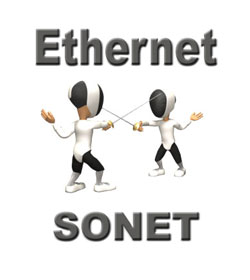By: John Shepler
Many tech companies and large corporations adopted fiber optic bandwidth service, specifically OC3 SONET, years ago. While some have upgraded to faster SONET options, others have continued using their reliable OC3 service.
 However, the emergence of 100 Mbps and faster Ethernet MAN and WAN bandwidth is challenging SONET’s dominance. Long-time users are exploring alternatives, while new customers are carefully considering their options.
However, the emergence of 100 Mbps and faster Ethernet MAN and WAN bandwidth is challenging SONET’s dominance. Long-time users are exploring alternatives, while new customers are carefully considering their options.
SONET (Synchronous Optical NETwork) within the SDH (Synchronous Digital Hierarchy) became the foundation for most metropolitan, wide area, and international networks in recent decades. Initially designed for large-scale telephone traffic, its ability to bundle numerous calls made it a natural fit for data transmission with the rise of computer networks and the internet.
SONET’s advantages include its maturity, widespread industry support, high reliability, and resilience against fiber cuts and equipment issues. Various service levels are offered, ranging from 155 Mbps to 100 Gbps. Costs have decreased, making even the entry-level OC3 SONET service accessible to smaller companies.
So why consider replacing a reliable service like SONET with newer Carrier Ethernet technology? The answer lies in cost, features, and scalability.
Ethernet is the communication standard for almost all devices, from corporate LANs and PCs to printers, routers, and even emerging “Internet of Things” devices. This begs the question: why not an all-Ethernet world?
Carrier Ethernet is a standardized version of Ethernet designed for long-distance communication, carrier-grade management, and provider compatibility, thanks to the Metro Ethernet Forum (MEF).
Comparing 100 Mbps Ethernet to OC3 SONET, both delivered over fiber optic cables, highlights key differences. Ethernet uses a simple copper or fiber patch cord for connection, while OC3 requires a special interface module to convert between Ethernet and SONET protocols.
This difference contributes to SONET’s decline. Converting between Ethernet and SONET introduces inefficiencies. Additionally, different interface modules are needed for each SONET level, unlike the universal nature of Ethernet.
SONET offers specific service levels, while Ethernet is inherently scalable. Carriers provide Ethernet ports with maximum speeds (e.g., 100, 1,000, 10,000 Mbps), allowing for flexible service levels within that capacity. This means businesses pay for actual bandwidth usage instead of fixed circuit capabilities.
Scalability also translates to cost savings. A 100 Mbps connection on a 1,000 Mbps Ethernet port is easily adjustable. With SONET, starting at the 155 Mbps OC3 level may mean purchasing more bandwidth than necessary. Upgrading Ethernet is typically faster and more flexible compared to transitioning between fixed SONET levels.
Besides its flexibility, Ethernet services are often more cost-effective than SONET per Mbps. Both offer high reliability, low latency, and robust bandwidth. SONET usually provides protected ring arrangements with dedicated bandwidth and very high reliability (99.999%).
However, businesses need to be mindful of the specific Ethernet service they choose. Carrier Ethernet can offer SONET-like features, including redundant path protection, high reliability, low latency, and symmetrical bandwidth. But less critical applications can opt for more affordable options like asymmetrical bandwidth, shared bandwidth, or unprotected circuits, which are suitable for general internet use or cloud backups.
Choosing between SONET and Ethernet depends on specific business needs. Consulting with a bandwidth expert who can provide insight and compare pricing from various carriers is recommended.

